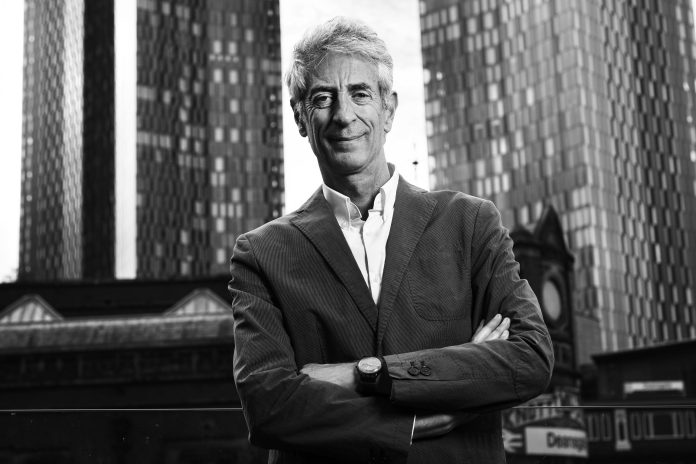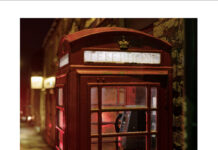Over the past 40 years, Andy Spinoza has met, interviewed and worked with just about anyone of note in Manchester, from Morrissey to Bernard Manning, Shaun Ryder to Sir Alex Ferguson, Frank Sidebottom to Andy Burnham.
Arriving in the city in 1979 as a wide-eyed student, Andy was an early member of the Hacienda, reported on Manchester’s music scene for NME and The Face, founded alternative magazine City Life, and spent a decade as a gossip columnist for the Manchester Evening News before launching his own PR company.
Now, Andy has written a book chronicling this culturally significant period in Manchester’s history, illustrated with photos by Kevin Cummins, Peter J. Walsh and others.
Published this month, Manchester Unspun: Pop, Property and Power in the Original Modern City looks at how Manchester’s post-industrial ruins, which inspired the world-famous Factory Records, Joy Division and the Hacienda, became a sky-high property boom dubbed ‘Manc-hattan’. And, as you’d expect from a skilled storyteller such as Andy, it’s a rollicking rollercoaster of a read.
“I knew I had some good stories, which I normally just tell in the pub or at a dinner party, about working with this person or a dust-up with that celebrity,” says Andy, who started writing the book in September 2020. Manchester Unspun is certainly packed with good stories, with a colourful cast of key Manchester characters woven throughout.

“I’m sure some people won’t be happy with how I’ve described them, but I’ve tried to be fair-minded,” says Andy. “I didn’t want to be too schmoozy about it.”
With key roles played by music and sporting legends, including Tony Wilson, Peter Hook, New Order, Peter Saville, Mick Hucknall, Sir Alex Ferguson and Gary Neville, this is an insider account of Manchester’s transformation.
Tony Wilson plays a large part in Manchester Unspun, and it’s not surprising to discover that he has had a huge influence on Andy on a personal level.
“Tony was a bright sun around which many creative people orbited and created a kind of supernova of culture,” says Andy.
“We all have mentors, even if we perhaps don’t realise at the time that they’re mentors. He gave a lot of people encouragement and support. I worked with him in a very direct way quite a few times.
“The last time I saw him was at a big event. He’d just come out of hospital, and I naively thought he was going to get better. But that was the last time I saw him. I still regret not having a proper conversation with him that night.”
The Hacienda is also a key part of the book, which has been published forty years after the legendary club’s launch. 

“The Hacienda was important in two ways,” says Andy. “It physically being there gave the kiss of life to a dying city centre, and it became the first regeneration project of the new Manchester. It cost a fortune – in fact, in the book by Stephen Morris [of New Order] he calculates that £18million was spent on the Hacienda, and that was private money, no grants were applied for.
“It was Manchester celebrating itself; it didn’t look to any agendas, official or otherwise. It was Manchester’s response to being so downtrodden and, if you like, despised by London. And it wasn’t just a cultural celebration, it was a political response. It was important intellectually and ideologically as well as physically.
“The media fixated upon certain episodes in its history, and that’s kind of become what people know about it. But it was far more interesting, complicated and varied than that.
“I know some people are sick of hearing about it, and I can see why people might be bored by some of the representations that have come out over the years. I’ve tried to reveal and disclose some other episodes that are less cliched. I hope that people are curious enough to go beneath that surface cartoon image.”
The book opens and closes with two striking maps showing how Manchester city centre has changed, from 1980 with a resident population of 500 and just a handful of tall buildings of over 20 storeys to 2022 with a resident population of 260,000 and tall buildings dotted all over, with more in the pipeline.

What does that sort of growth mean for Manchester?
“I’m as conflicted as everyone else,” says Andy. “We all want to see Manchester regenerated, but it’s difficult not to erase character and charisma.
“I’m a city centre kind of guy. I like that mix of cultures and classes, and creative sparks fly when everything isn’t a handsomely refurbished hipster paradise.
“But in the nineties or even noughties, music venues would open, restaurants would open, but they wouldn’t survive. They often did business on a Friday and Saturday but couldn’t do it seven days a week.
“Now, you’ve got an army of under-40s living in the city centre who need to be fed and love going out. They’ve made all that cultural activity viable.
“It is fair to say that there’s a housing shortage in the country, and it is obviously the case that young people are flocking in their tens of thousands into the Manchester and Salford’s interlocking city centres.”
Looking to the future, what does Andy think Manchester might look like in another forty years?
“Well, it’ll certainly be taller,” says Andy. “I’m sure every plot of land that could have a tall building on it will have a tall building on it.”
One thing’s for sure; Manchester will never be short of interesting stories.
Manchester Unspun: Pop, Property and Power in the Original Modern City by Andy Spinoza is out now, published by Manchester University Press.







